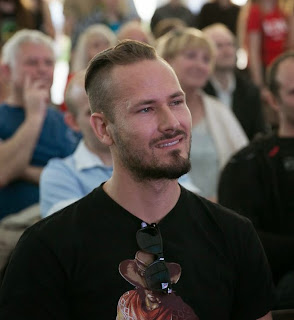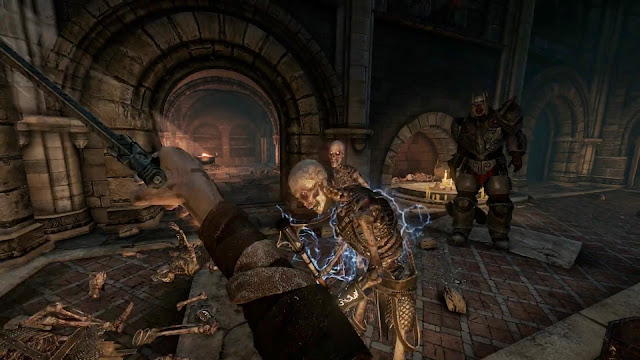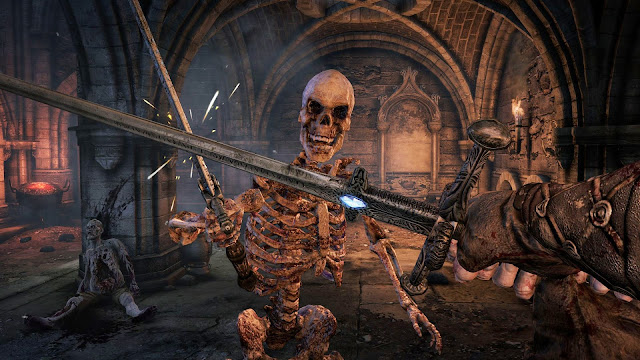One of the upcoming games that we were anticipating a great deal was Techland’s Hellraid. A first person co-operative slash-em-up set in a gothic horror nightmare sounded like a lot of fun to us, especially coming from the team responsible for the creative Dead Island and Dying Light.
Unfortunately in an announcement on its blog overnight, Techland has decided to postpone development on the game. “In the recent months we conducted an internal analysis and came to the conclusion that Hellraid, in its current shape and form, is not meeting our own expectations for this project. Therefore, we decided the best course of action would be to send it back to the drawing board and invent our dark fantasy title anew,” the company said in a statement on the website.
So it hasn’t been cancelled, but Hellraid is a long way from completion now, and may well look very different from what we originally saw of it.
This was actually a bigger problem for me than not getting a game to play a game that I was really looking forward to this year. My book, Game Art, actually was to have an interview with Hellraid’s lead artist, Konrad Czernik, within it. Unfortunately, with the uncertain future of the game, it wouldn’t be a good idea to publish the interview in the book, as there’s no guarantee that the final product, should it release, will still be relevant to the content of the interview.
Now, there’s still over 20 interviews showcasing over 40 games in Game Art, so please don’t worry about the content that will be in there (there’s a full list of the developers that were interviewed in the comments section of this article)! It’s with the printers now, and I love how it’s shaping up! However, I really enjoyed and appreciated the opportunity to interview Czernik, and I didn’t want to let his interview just disappear to the recesses of my hard drive’s archives, so I thought I would simply publish it below. Obviously the interview was done when the game was still well into development on its current track, well before yesterday’s news broke, but I’m hoping that this gives you a sense of what the game, in its current form, could have been.
Related reading: Why I wrote Game Art; an introduction to my book.
Additionally, you’ll get a sense of what the rest of the book will offer in terms of its interviews below. I hope you enjoy reading!
And fingers crossed Hellraid makes a spectacular return, because it was really promising to be something special.
Konrad Czernik has spent his entire professional career with Polish independent developer, Techland. In that time he has worked on a truly broad range of games as a concept artist, from the bright and cheerful candy-themed mobile game, Sugar High, through to the zombie-infested tropical nightmare of Dead Island, and Mexican gunslinger-themed Call of Juarez games.
Now promoted to the role of lead concept artist, Czernik has also led development on games including Hellraid, a gothic horror-themed action game that is reminiscent of classic first person shooters such as Heretic and Hexen.
The nature of Czernik’s work has meant he has often needed to juggle difficult projects at a time, including themes as diverse as working on both the colourful Sugar High and the nightmarish Hellraid at the same time. You might think that it would be difficult for an artist to switch between moods instantly, as is often when working on multiple projects simultaneously, but according to Czernik, this has not been a problem at all.
“I like that kind of dynamic working, and in fact that’s the reason I’m in this company,” Czernik said. “I like cartoons so much and I love Pixar movies. It was great to be able to be influenced by them when designing Sugar High.
“But it was also like I was getting up twice a day because I was waking up in this sunny world first, and then I was waking up again in a nightmare when working on Hellraid. I mean that in a positive way because I love horror as well.”
A Brief History Of The Gothic, Leading Up To Hellraid
Hellraid is a Gothic horror-themed fantasy action game; it’s a game that comes from a rich artistic tradition that has been developing and refining itself for close to 1,000 years. The original Gothic art was an export of northern France in the 12th century, and while the artistic movement is generally considered to have died out some time during the 16th century, as Europe moved into the Renaissance, the traditions have been kept alive through other media right through to the modern era. Four centuries is a long time for a single art movement, and Gothic art initially proved influential in art, architecture, literature and sculpture. Gothic horror, meanwhile, is a relatively short-lived approach to literature that is generally credited of being ‘invented’ by Horace Walpole in the 1763 novel The Castle of Otranto. Later famous Gothic horror literature authors include Mary Shelley with Frankenstein, Edgar Allan Poe with his short stories (such as The Telltale Heart) and Bram Stoker with Dracula.
Though they existed in separate eras, the Gothic horror genre of literature was heavily inspired by the Gothic romance art movement of the 12th-16th century. A central theme of most Gothic novels, for instance, is a setting centred on traditional Gothic architecture such as monasteries and castles. These environments often take on a life or character of their own within the plot, holding mysteries and secrets that the human characters need to uncover as part of the novel’s plot. While Gothic literature passed out of fashion as the dominant “horror” genre, replaced with the contemporary horror works of artists such as H.P. Lovecraft and Stephen King, monsters such as Dracula, succubi and werewolves that were so core to the Gothic horror tradition have continued to inspire modern artists. Every so often a film director will take on the challenge of recreating the story of Dracula, for instance. And, in the games industry, we have the likes of Hexen, and now Hellraid.
The Challenge Of Illustrating Gothic Horror
The Gothic horror that Czernik was tasked with capturing in Hellraid was in itself very different in both tone and theme than his previous horror project, Dead Island. Dead Island is a very modern approach to horror. Focused as it is on zombies, which were popularised in their current form by films such as George A. Romero’s Night of the Living Dead, the zombie horror genre is one which speaks greatly to a modern sense of horror.
But for Hellraid, Gothic horror is awkward to work with, as the stuff within it that was once scary is no longer relevant. Horror is a genre of entertainment that has always been a reaction to social fears. As a result, horror as a genre ages quickly, as what frightens one generation does not concern the next.
We can see this play out in the film industry, where the cyclical nature of the horror genre means that it makes a resurgence every couple of decades, only to wane in popularity until the next “scary” thing comes along. In the 70s and 80s for instance, social tensions regarding an increasingly liberal youth that was increasingly experimenting with sex and drugs, manifested in horror classics such as Halloween and Friday the 13th, where the film’s “monster” would “punish” transgressive teenagers. More recent horror franchises, such as Saw or Paranormal Activity, instead tap into our fears around the increasing voyeuristic obsession that society has with explicit footage on the news and reality television.
What works as horror for one group of people won’t work for another, and the Gothic horror that Hellraid aims to tap into is a very distant set of fears to our own. “Gothic art is not attractive to us now,” Czernik said. “It’s very naive, even. The artists of the time were painting for people who couldn’t read, and so these paintings were being used to explain heaven and hell to these people in simple, visual terms.” Gothic works, such as the Danse Macabre paintings that depict Death summoning dead commoners and nobles alike to dance on graves, were designed to remind people of the fragility of life at a time where the bubonic plague and wars were decimating populations.
Obviously we don’t have issues with the bubonic plague any longer, and we only need to switch on the evening news to be reminded of the fragility of life. Danse Macabre artworks are historical and intellectual curiosities, but are not examples of horror by any contemporary standard.
Czernik and his team were also inspired by the works of Gothic artists such as Hieronymus Bosch, which certainly have a sensation of horror about them, even to us today, but again these proved problematic when it came to using them as inspiration for a game. “There is so much abstraction of the spaces, characters and animals of those art works,” he said. “There are people with the heads of creatures, and strange walking lizards. It is so hard to relate to these kinds of designs in modern games. We needed to find something more realistic in design and lighting.”
So Czernik and his team looked at works of the broader Romantic era, a genre that shares a close relationship with the Gothic genre, but is more grounded in realism and beauty than monstrosities, which ironically means that it’s a genre that better works in games where a “clean” canvas is immensely preferred by players when compared to abstract ideas about space and character design. Being located in Poland they were also fortunate to be able to access nearby castles and churches built during the era, and so were able to take weekend trips to study and research the architecture of the era, and how the spaces of such areas work.
Authenticity is important to Czernik in all the work that he does. However, he ran into a final challenge in the design of Hellraid as a Gothic-themed horror game; Gothic art is loaded with religious imagery. At the time when these works were created, the religious imagery was used as part of the educational theme for people who lacked literacy skills (i.e. “heaven looks like this, hell looks like that”), but in modern entertainment industries, religious imagery, especially when it starts to involve demons and the darker side of religion, has the real potential to alienate audiences and offend players.
“We don’t want to offend anyone,” Czernik said. “We have implied religious imagery, as we have destroyed altars and architecture that looks like a church, but we’ve removed the religious icons from the game as we don’t want to make people uncomfortable.”
Although the game features plenty of grotesque imagery and monster design, what was ultimately important to Czernik was nailing the atmosphere; creating a game that drips with a dark, yet classically beautiful aesthetic style, and one that is able to surprise players and keep them interested in seeing what kind of terrors the next environment will offer.
“I like the psychology of horror,” he said. “I find it fascinating in a modern context because we’re all tired of turning on the news and seeing everything. Horror is no longer just about cutting heads off; it’s about the climate, or atmosphere, and the spirit of the game. This is my focus,” he added.
Making The Visuals Core
Hellraid relied heavily on the work of Czernik and the project’s other concept artists. Before the game had a publisher, narrative, or was anything more than an idea, it was the work of the concept artists that motivated the team and united them behind a single vision.
“We worked on the concept art first, because we initially only had an idea to work with. It was the idea of having ‘hell on earth,’ but in everyone’s head that could look very different,” Czernik said. “If everyone in the team didn’t have the same vision it would have been very difficult to actually finish anything. That’s the value of concept art; it helps to make everyone believe in the project, by unifying them behind a single vision.”
“It even helps in a business sense because when we’re looking for a publisher, the concept art helps to explain the precise nature of the proposed project. Before the project starts in full, there’s the concept art, and it’s really the most permanent part of the project – the story and even gameplay mechanics often change, but the early sketches keep everyone focus.”
“The first months are always quite messy and creative, and that’s the best time on a project; it’s then that we know the kind of game that we’ll end up with.”
– Matt S.
Editor-in-Chief
Find me on Twitter: @digitallydownld











